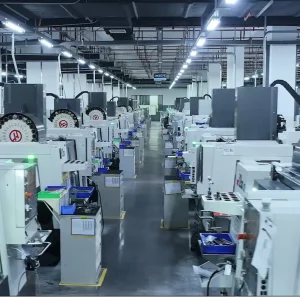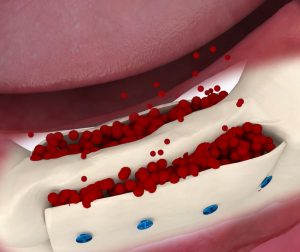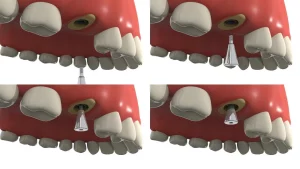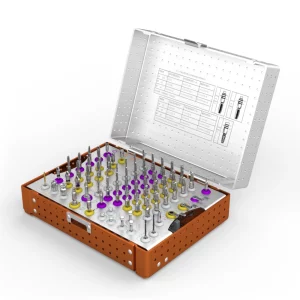Dental implants are a restorative procedure that involves surgically placing an artificial material implant into the alveolar bone at the site of a missing tooth, restoring both function and aesthetics. Dental implants primarily consist of several key components: the implant, screws or connectors, and the artificial crown.
An important component in the dental implant process is the healing abutment (also known as a healing cap or healing sleeve). The healing abutment serves as the intermediary between the implant and the crown, stabilizing either a temporary or permanent restoration during the healing phase following implant placement. It protrudes through the gum tissue, maintaining bone integration and promoting the growth of periodontal soft tissues. Additionally, it helps shape the gum contour and prevents bacteria and food debris from entering the implant, facilitating soft tissue healing and creating a seal around the neck of the implant.
Healing abutments come in various types based on their shape, material, and processing methods, such as conical healing abutments, cylindrical healing abutments, and titanium healing abutments. As a crucial component in the dental implant process, the healing abutment plays an important role in promoting healing and maintaining the stability of the implant.

What is a healing abutment?
A healing abutment, also known as a healing cap or healing sleeve, is a critical component in dental implant surgery. It is defined as a device designed to cover and protect the top of the implant after placement, while promoting the healing of the gum tissue surrounding the implant. The primary purpose of the healing abutment is to establish a conducive healing environment between the implant and the gum tissue, preventing external contaminants such as bacteria and food debris from entering the implant area. This ensures that the implant can safely and stably integrate with the surrounding bone tissue. By facilitating the healthy growth and shaping of the gum tissue, the healing abutment provides a solid foundation for the subsequent placement of a permanent restoration, ensuring the overall aesthetics and functionality of the dental implant.
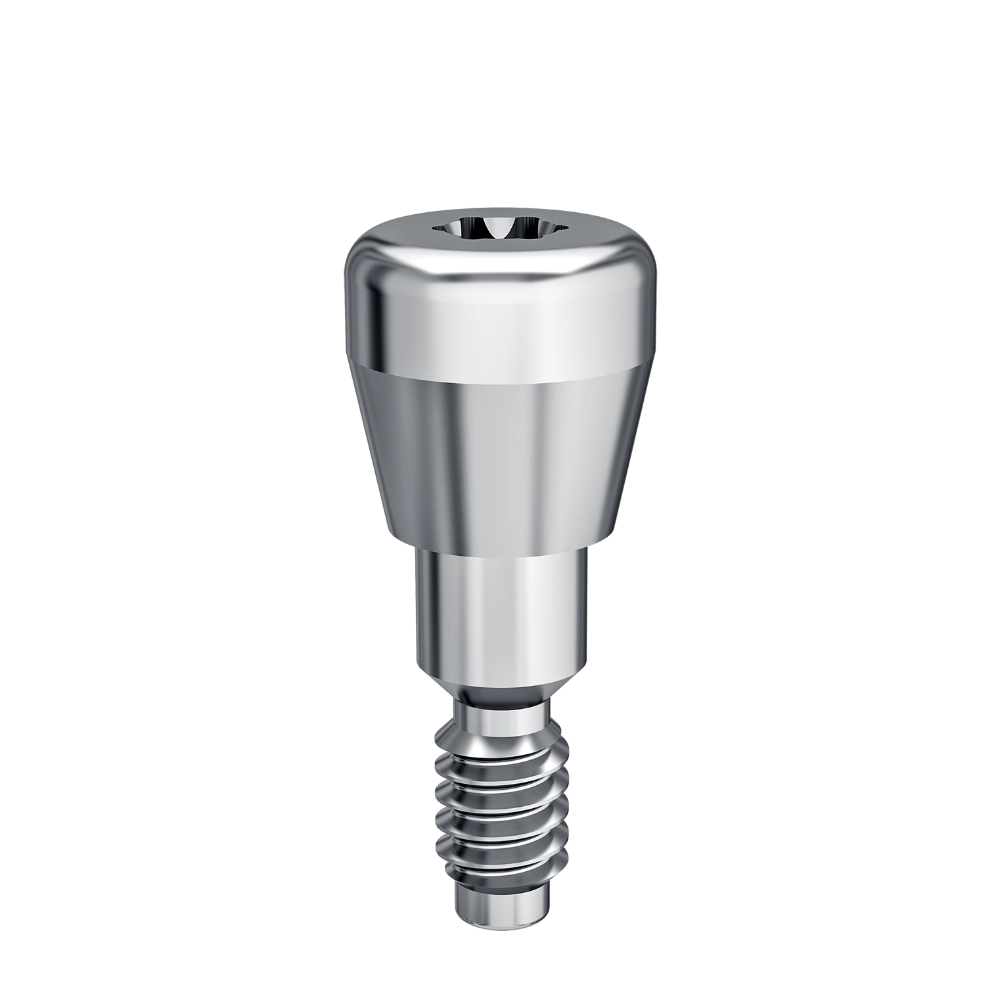
When is the healing abutment placed?
The timing for placing a healing abutment depends on the type of dental implant surgery, which mainly falls into two categories: single-stage surgery and two-stage surgery. In both cases, placing the healing abutment is a crucial step in the dental implant procedure. It helps promote the healing and shaping of the gum tissue around the implant, providing a solid foundation for the subsequent installation of the permanent restoration. Patients should consult with a qualified professional and make decisions based on their oral conditions and the doctor’s recommendations when choosing the surgical type.
Single-Stage Surgery
In single-stage surgery, the implant and the healing abutment can be placed simultaneously. This means that during the surgery, the doctor will implant the implant into the alveolar bone and immediately install the healing abutment on top. The advantage of this method is that it simplifies the surgical process and reduces the number of visits for the patient. Placing the healing abutment and the implant at the same time helps quickly establish a stable healing environment after the implant is placed, promoting the growth and shaping of the gum tissue. However, this method requires a higher level of oral condition and surgical skill from the practitioner.
Two-Stage Surgery
In contrast, two-stage surgery is more common and conservative. During the first stage of the surgery, the doctor will implant the implant into the alveolar bone and then stitch the wound closed, allowing the implant to integrate with the bone tissue in a fully sealed environment. The healing time for this stage typically requires 3 to 6 months, depending on the individual circumstances of the patient and the doctor’s recommendations.
In the second stage of the surgery, the doctor will expose the implant through a small incision, remove the healing screw (if present), and then install the healing abutment. The primary purpose of this stage is to facilitate further healing and shaping of the gum tissue around the implant, preparing for the installation of the permanent restoration.
Preferred Situations for Two-Stage Surgery Include:
- Patients with complex oral conditions that require longer healing times to ensure good integration of the implant with the bone tissue.
- Doctors wishing to better control the surgical process and the patient’s recovery through staged procedures.
- Patients wanting to minimize surgical risks and increase the likelihood of a successful outcome.
Differences Between Healing Abutments and Cover Screws
Healing abutments and cover screws play different roles in dental implant surgery, primarily reflected in their functions and designs. When choosing which component to use, doctors consider the specific circumstances and surgical needs of the patient.
Healing Abutment
- Function: The main function of a healing abutment is to help shape and support the gum tissue during the healing period following the implant placement. It guides the gums to form an appropriate shape around the implant, providing a solid foundation for subsequent crown restoration.
- Design: Healing abutments typically have a wider base to allow sufficient space for crown placement after healing. Their design also takes into account compatibility and stability with the gum tissue to ensure a smooth healing process.
Cover Screw
- Function: The primary function of a cover screw is to protect the implant from debris, bacteria, and soft tissue damage during the healing process. It acts as a closure and protective barrier, reducing the risk of infection.
- Design: Cover screws are usually smaller and are flush or slightly elevated relative to the implant, ensuring they fit securely on the implant. This design helps prevent external contaminants from entering the implant while not putting excessive pressure on the surrounding soft tissues.
Postoperative Care for Healing Abutments in Dental Implant Surgery
Healing abutments are a crucial component in dental implant surgery, and proper postoperative care is essential for ensuring the success of the procedure and the rapid recovery of the patient. Here are some important points regarding postoperative care for healing abutments:
Common Postoperative Symptoms
- Swelling: Patients may experience swelling around the gums and face near the implant site after surgery. This is a normal physiological response that usually subsides within a few days.
- Discomfort or Pain: Some patients may feel mild discomfort or pain in the implant area, especially during the first few days following the surgery.
Recommended Management Techniques
- Using Ice Packs: After the surgery, patients can apply ice packs gently to the surgical area to help reduce swelling and pain. Ice packs should be changed periodically to avoid skin frostbite.
- Over-the-Counter Pain Relievers: Patients may use over-the-counter pain relievers (such as ibuprofen) to alleviate pain and discomfort, but should do so under the guidance of their doctor. It is advisable to avoid medications like aspirin that may affect blood clotting.
importance of Following Specific Postoperative Care Instructions from the Surgeon
- Maintain Oral Hygiene: Patients should maintain good oral hygiene habits, brushing their teeth twice daily and rinsing their mouth after meals. Using an antibacterial mouthwash as recommended by the doctor can help prevent infection.
- Avoid Irritants: During the healing process, patients should avoid smoking, drinking alcohol, and consuming spicy or irritating foods, as these can irritate the surgical area and impede healing.
- Regular Follow-Up Appointments: Patients should adhere to their doctor’s instructions for regular follow-up appointments to allow the doctor to monitor the healing of the implant and surrounding gum tissue. This helps identify and address any potential issues early on.
- Pay Attention to Rest: Adequate rest is important after surgery, and patients should avoid strenuous activities to minimize stress and irritation on the surgical site, aiding in wound healing and reducing bleeding.
In summary, following the specific postoperative care instructions provided by the surgeon is vital for the successful healing of the healing abutment and the swift recovery of the patient. Patients should closely monitor their physical condition and seek medical attention if any discomfort arises.
Conclusion
Healing abutments not only provide essential support and protection during the healing period following implant placement but also ensure the proper shaping and contouring of the gum tissue, laying a solid foundation for subsequent crown restoration. By promoting good integration between the implant and surrounding bone tissue, as well as maintaining the health of the gum tissue, healing abutments contribute to the long-term stability and success rate of dental implants.
The timing of healing abutment placement depends on the specific type of implant surgery and the individual patient’s circumstances. In single-stage surgery, the implant and healing abutment may be placed simultaneously, simplifying the surgical process and reducing the number of visits for the patient. In contrast, in the more common and conservative two-stage surgery, the healing abutment is placed during a second procedure after the implant has been inserted and has undergone a period of healing. This step is aimed at ensuring adequate integration of the implant with the bone tissue and preparing for the subsequent shaping of the gum tissue.

